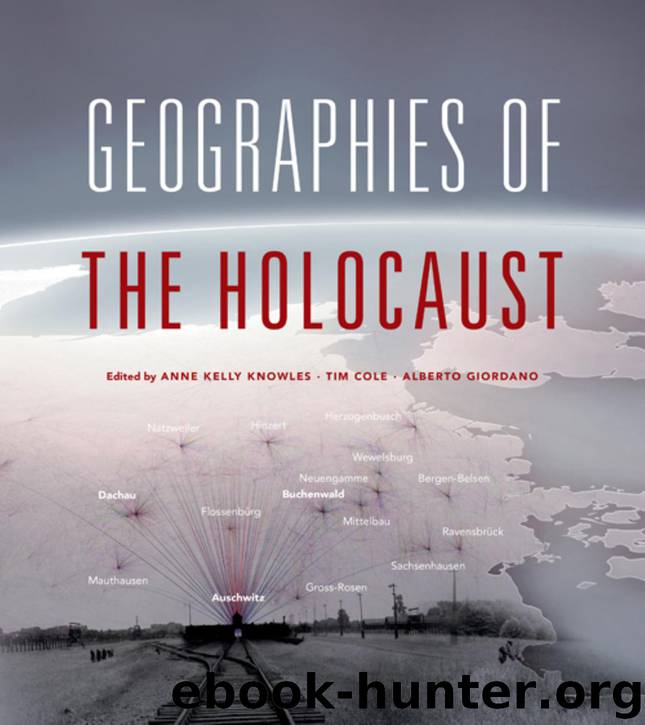Geographies of the Holocaust by Cole Tim Knowles Anne Kelly Giordano Alberto & Tim Cole & Alberto Giordano

Author:Cole, Tim, Knowles, Anne Kelly, Giordano, Alberto & Tim Cole & Alberto Giordano
Language: eng
Format: epub
Publisher: Indiana University Press
Published: 2014-03-14T16:00:00+00:00
5
Bringing the Ghetto to the Jew
Spatialities of Ghettoization in Budapest
Tim Cole and Alberto Giordano
BUDAPEST WAS ONE OF APPROXIMATELY 150 TOWNS AND cities in Hungary where Jews were restricted to urban ghettos during the Holocaust.1 Elsewhere in occupied Eastern Europe, local officials created ghettos to confine and control Jewish residents or to hold Jews sent from elsewhere.2 While noting that ghettos were not implemented in all occupied cities and towns, the late Raul Hilberg argued in his groundbreaking work The Destruction of the European Jews (1961) that concentration and segregation–the core processes of ghettoization–were central elements of the Holocaust.3 In contrast, Dan Michman–emphasizing the physical place of ghettos contra Hilberg’s process-driven focus on ghettoization–argues that ghettos were limited to a handful of countries in Eastern Europe, that they varied significantly, and were not vital to the destruction process. Michman does see the creation of ghettos in Poland as a “sharp escalation of the Nazis’ anti-Jewish policy,”4 but not the radicalization force in earlier so-called functionalist historiography.5 Whereas Michman seeks to explain ghettoization as a material manifestation of the Nazis’ anti-Semitic perceptions of Ostjuden in Poland, other scholarship more convincingly interprets early Nazi ghetto policy as the urban plank of a broader imperialist project of reshaping and “Germanizing” occupied Poland.6 In contrast to the slim scholarship on the motivations behind ghettoization, a richer historiography of daily life, Jewish institutions, and resistance movements within the ghettos has emerged. Some is comparative,7 but most focuses on individual large ghettos, in particular Warsaw and Łódź.8 Yet very few scholars have examined the material transformation of place-making policies into real places or the geographies of everyday life in the ghetto.9
One of the few exceptions is scholarship on the Budapest ghetto, which has been the focus of a number of studies that look explicitly at the geography of ghettoization.10 In earlier work, Tim Cole examined the shifting shape of the Budapest ghetto as a way to understand the changing motivation of the city’s “doctors of space”–borrowing a term from the work of Henri Lefebvre–namely, those who restructured residential and public space along racialized lines.11 Cole’s work identified two key binaries. He emphasized the view of ghettoization as variously a policy of creating sites of Jewish absence, achieved by “cleansing” parts of the city by removing Jews to ghettos, and of creating sites of Jewish presence, by concentrating Jews in particular places in the city. Shifts between the binary of absence and presence reflected the move from utopian planning and concern about the socioeconomics of ghettoization to policies of pragmatism.12 Cole also explored the interplay between concentration and dispersion as ghettoization was discussed, planned, and enacted in a capital city subject to aerial bombing.13
These studies laid a foundation for understanding the temporal dynamics of ghettoization and the spatial manifestation of changing policies, but they were limited in a number of significant ways. First, although Cole had mapped dispersed ghettoization in Budapest, he did this by simply mapping Jewish-designated buildings as points on a map, without taking into account
Download
This site does not store any files on its server. We only index and link to content provided by other sites. Please contact the content providers to delete copyright contents if any and email us, we'll remove relevant links or contents immediately.
| Historic | Information Systems |
| Regional |
Man-made Catastrophes and Risk Information Concealment by Dmitry Chernov & Didier Sornette(5901)
The Revenge of Geography: What the Map Tells Us About Coming Conflicts and the Battle Against Fate by Kaplan Robert D(4026)
Zero Waste Home by Bea Johnson(3762)
COSMOS by Carl Sagan(3539)
Good by S. Walden(3468)
In a Sunburned Country by Bill Bryson(3466)
The Fate of Rome: Climate, Disease, and the End of an Empire (The Princeton History of the Ancient World) by Kyle Harper(2988)
A Wilder Time by William E. Glassley(2805)
Camino Island by John Grisham(2749)
The Ogre by Doug Scott(2620)
Organic Mushroom Farming and Mycoremediation by Tradd Cotter(2616)
Human Dynamics Research in Smart and Connected Communities by Shih-Lung Shaw & Daniel Sui(2459)
Energy Myths and Realities by Vaclav Smil(2422)
The Traveler's Gift by Andy Andrews(2396)
9781803241661-PYTHON FOR ARCGIS PRO by Unknown(2311)
Inside the Middle East by Avi Melamed(2294)
Birds of New Guinea by Pratt Thane K.; Beehler Bruce M.; Anderton John C(2214)
A History of Warfare by John Keegan(2172)
And the Band Played On by Randy Shilts(2116)
